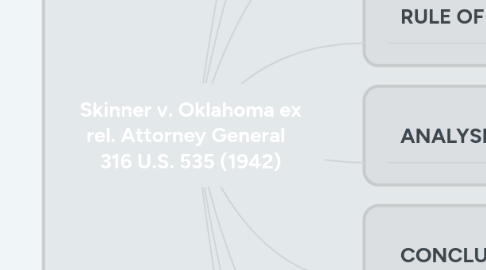
1. ISSUE
1.1. Whether the Plaintiff's 14th Amendment rights were violated under Oklahoma's Habitual Criminal Sterilization Act and does the said Act address due process and equal protection clause of the 14th Amendment?
2. FACTS
2.1. Parties
2.1.1. Mr. Skinner, Plaintiff
2.1.2. State of Oklahoma, ex rel. Attorney General, Defendant
2.2. What happened
2.2.1. Oklahoma Habitual Criminal Sterilization Act of 1935 allowed the state to sterilize "habitual criminals," i.e., recidivists convicted two times or more for "crimes of moral turpitude." Attorney General office was tasked with the initiation of the sexual sterilization procedure. An inmate was provided with a notice and given an opportunity to request a hearing and a jury trial.
2.2.1.1. Mr. Skinner has three convictions for crimes of moral turpitude: theft (1926) and rubbery with firearms (1929 and 1934). In 1936 he was was notified about upcoming proceedings and requested a jury trial claiming violation of the 14th Amendment.
2.3. Procedural history
2.3.1. The plaintiff was afforded a jury trial at the Oklahoma State Court in 1936. The Court instructed the jury that the only question under consideration was whether the plaintiff could undergo a sterilization procedure without harm to his health. The jury concluded that procedure was not detrimental to the plaintiff's health and this decision was subsequently affirmed by the Supreme Court of Oklahoma. US Supreme Court reversed the decision.
3. ISSUE BEFORE THE COURT
3.1. Whether a due process and equal protection clause of the 14th Amendment renders the Oklahoma Habitual Criminal Sterilization Act unconstitutional as plaintiff will be deprived of his right to procreate?
4. RULE OF LAW
4.1. Was the equal protection clause of the 14th Amendment violated by selecting a group of citizens (habitual criminals prosecuted for specific type of felonies) and discriminating against them?
4.1.1. Is the right to procreate a fundamental human right protected by the Constitution?
4.1.1.1. Was the Act penal in nature and cruel, as the vasectomy is considered an 'irreparable damage?"
5. ANALYSIS
5.1. Plaintiff
5.1.1. Argument: The plaintiff argued that forced sterilization constituted a "cruel and unusual punishment" causing irreparable damage to his health.
5.1.1.1. Argument: Due process and equal protection clause of the 14th Amendment were violated as the the plaintiff was not awarded an opportunity to have a hearing to establish whether he is able to parent a socially positive child.
5.2. Defendant
5.2.1. Argument: The Act serves as a public health and safety tool as it diminishes the societal burden of having criminal elements in its midst. Forced sterilization assures that habitual criminals will not be able to procreate. Thus, the society will gradually "clean" itself from the criminal elements.
5.3. Court ruling
5.3.1. The Court discusses whether the right to beget a child constitutes a "fundamental <human> right." The Court ruled that"cruel," unjust, and unconstitutional Sterilization Act indeed violated provisions of the 14th Amendment for the due process and equal protection under the law. The Court pointed out that Oklahoma's state laws differentiated punishments for the similar charge. Specifically, embezzlers were exempt from the forced sterilization but all others prosecuted for crimes that caused the same monetary damage were subject to this law. Thus, the plaintiff's equal protection rights had been infringed upon. The lower court's decision was reversed.
5.3.1.1. In terms of the protection of the society from the criminal elements, the Court compared forced sterilization of the habitual criminals to the practice of eugienics. The Court stated that "marriage and procreation are fundamental to the very existence and survival of the race." Since there were no scientific studies proving that criminal traits are heritable, an assumption that children of the anti-social elements are doomed to the same fate is far-fetched.
6. CONCLUSION
6.1. The Court ruled that the Oklahoma Habitual Criminal Sterilization Act violated the equal protection clause of the 14th Amendment.
7. IMPACT
7.1. Riswold v. Connecticut (1965) The state of Connecticut prohibits use of contraception (Comstock Law) for birth control. In this case, the U.S. Supreme Court considered the statute to be a violation of a marital couple's right to privacy. Skinner v. Oklahoma was cited in regards to the "basic civil rights of man."
7.1.1. Gerber v. Hickman (2002) The plaintiff serves life sentence in the state of California. He petitioned for a permission to submit a sperm sample so his wife could be artificially inseminated. The state court and court of appeals ruled against the plaintiff on the grounds of "incarceration survives procreation" postulate but the case was reversed and remanded for further hearing by the U.S. Supreme Court. Skinner v. Oklahoma was cited in regards to the equal protection clause, which did not apply in this case. The right to be free from compulsory sterilization while incarcerated and the right to procreate while incarcerated are substantially different things.
8. IMPORTANCE
8.1. Subjective state statute administered without due process.
8.1.1. In the US, forced sterilization targeted criminals and disenfranchised populations (mentally ill, people of color, disabled, and indigent). Unfortunately, the "science' of eugenics is alive and well in the country. For instance, in 2010 more than 100 women prisoners in California were sterilized.
8.2. Violation of the informed consent and due process.
8.2.1. Forced sterilization compromised physicians' responsibility to do no harm, professional ethics, and moral principles.
8.3. Undue influence and coercive practices
8.3.1. Voluntary sterilization of the prisoners remains acceptable practice in the U.S. penitentiary system. The prisoners can elect to undergo voluntary sterilization procedure in exchange for sentence decrease.
9. INFLUENCE
9.1. Forced sterilization is not performed anymore. Skinner v. Oklahoma served as a precedent for multiple laws on reproductive rights.
9.1.1. Griswold v. Connecticut Ruled that contraception is a matter of a marital couple's privacy. Roe v. Wade Affirmed a woman's right to have an abortion under the 14th Amendment. Loving v. Virginia Overturned prohibition on interracial marriage as a basic civil right.
